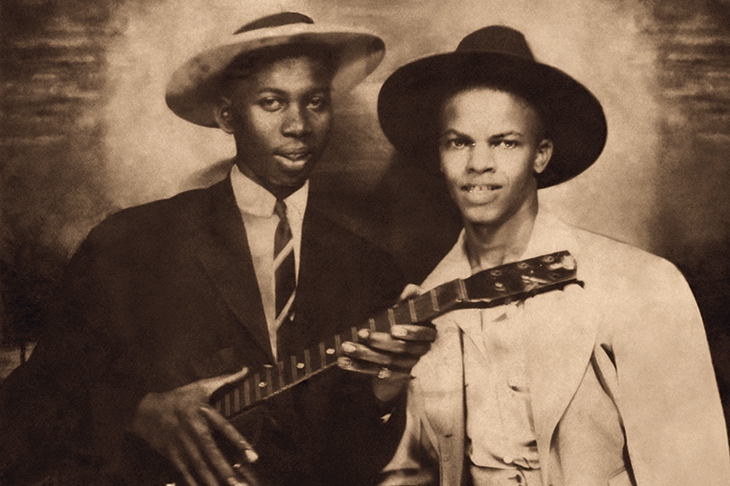Whatever would Robert Johnson, self-styled King of the Delta Blues, have made of the Black Lives Matter movement? His was certainly a life that mattered, but it was lived at a time when black lives mattered not a jot to white America. The circumstances of his death in 1938, at the age of 27 (he was probably poisoned by a jealous rival), demonstrate the disenfranchised existence of any peripatetic black performer in Depression-era USA. The murder was never investigated and his body was dumped in an unmarked grave.
And that would have been that had he not recorded 29 songs that represented the paradigm of delta blues for pale young acolytes such as Mick Jagger and Eric Clapton — and Bob Dylan, who in 1973 dedicated his first collected works to Johnson and later wrote: ‘If I hadn’t heard him, there probably would have been hundreds of lines of mine that would have been shut down.’ Johnson’s influence lingers on in Dylan’s 39th studio album, issued two months ago.
It took until 1961 for all 29 of Johnson’s tracks to be released officially. Before then his memory had been preserved solely by his family of (largely) stepbrothers and sisters, and on rare 78s, and tape transfers of same, by fastidious, almost exclusively white collectors.
Robert Johnson’s murder was never investigated, and his body was dumped in an unmarked grave
Meanwhile, attempts to write his biography would prove as ill-fated as his life. The first serious researcher, Mack McKormick, worked on his appositely named Biography of a Phantom for three decades without publishing any of his findings. Stephen Calt, whose oral biography of Johnson’s contemporary Skip James has few peers, delivered one in 2001, but both UK and US publishers passed on it. And Steve LaVere, the villain of Brother Robert, always claimed he was working on a biography, yet it too came to nothing.
Which makes the publication of this book by a living, breathing 93-year-old stepsister — no matter how slim and painted over by family hearsay — astonishing, and I found Annye Anderson’s judicious remembrance of the man who lit up her childhood a joy.
Though the memoir section runs to just 80 pages — followed by a similar length essay on how Johnson’s music was stolen from his family, largely by white men with forked tongues and law degrees — and comes from someone who was only ten when her photo-booth portraits on its cover, the phantom sibling clutching his guitar and looking younger than yesterday. Like the Droeshout portrait of Shakespeare, there is something otherworldly in those eyes. Just a boy-man, he shall not grow old.
Where Anderson’s account delights most is in the details it provides of Johnson’s life in Memphis — a musical mecca even then — when he came to visit. We learn of the music he played (what one wouldn’t give to hear his version of ‘Froggy Went a-Courtin’), and the movies he saw. Just the idea of him teaching his step-sister ‘Let Yourself Go’ from the Astaire-Rogers film Follow the Fleet, removes him from the mythic milieu in which blues scholars have squarely placed him and puts him somewhere real.
We’re also told which musical heroes he revered. Top of his personal pops, apparently, were Jimmie Rodgers and Gene Autry, purveyors of hillbilly music. Well, I never. Rodgers’s ‘Waiting for a Train’ was his favourite, which shows he had good taste. But of course his producer at Columbia, Don Law, would never have allowed him to cover that song officially. It was a Ralph Peer copyright, and as such strictly off limits.
Instead, Johnson recorded examples of ‘the devil’s music’.Yet Anderson insists her stepbrother was a churchgoer and a believer — as he surely was. Could he have evoked the devil so powerfully if he hadn’t been? The note he managed to write on his deathbed proves that he was both literate and liturgical. It read: ‘Jesus of Nazareth, king of Jerusalem, I know that my Redeemer liveth and that He will call me from the grave.’
That his music should have been interpreted as the epitome of a man in league with the devil clearly pains the doughty nonagenarian. The tradition of personalising exchanges with the devil in song dates back to the 15th century, and was for a long time strictly a white tradition. Johnson seized on the power of the imagery, but who’s to say it came from the blues tradition? Indeed, after reading Anderson’s account, one comes away firmly convinced that folk and blues to him were kindred spirits and musical forms that — had he lived — he could have shuttled between as easily as his very own Judas.






Comments